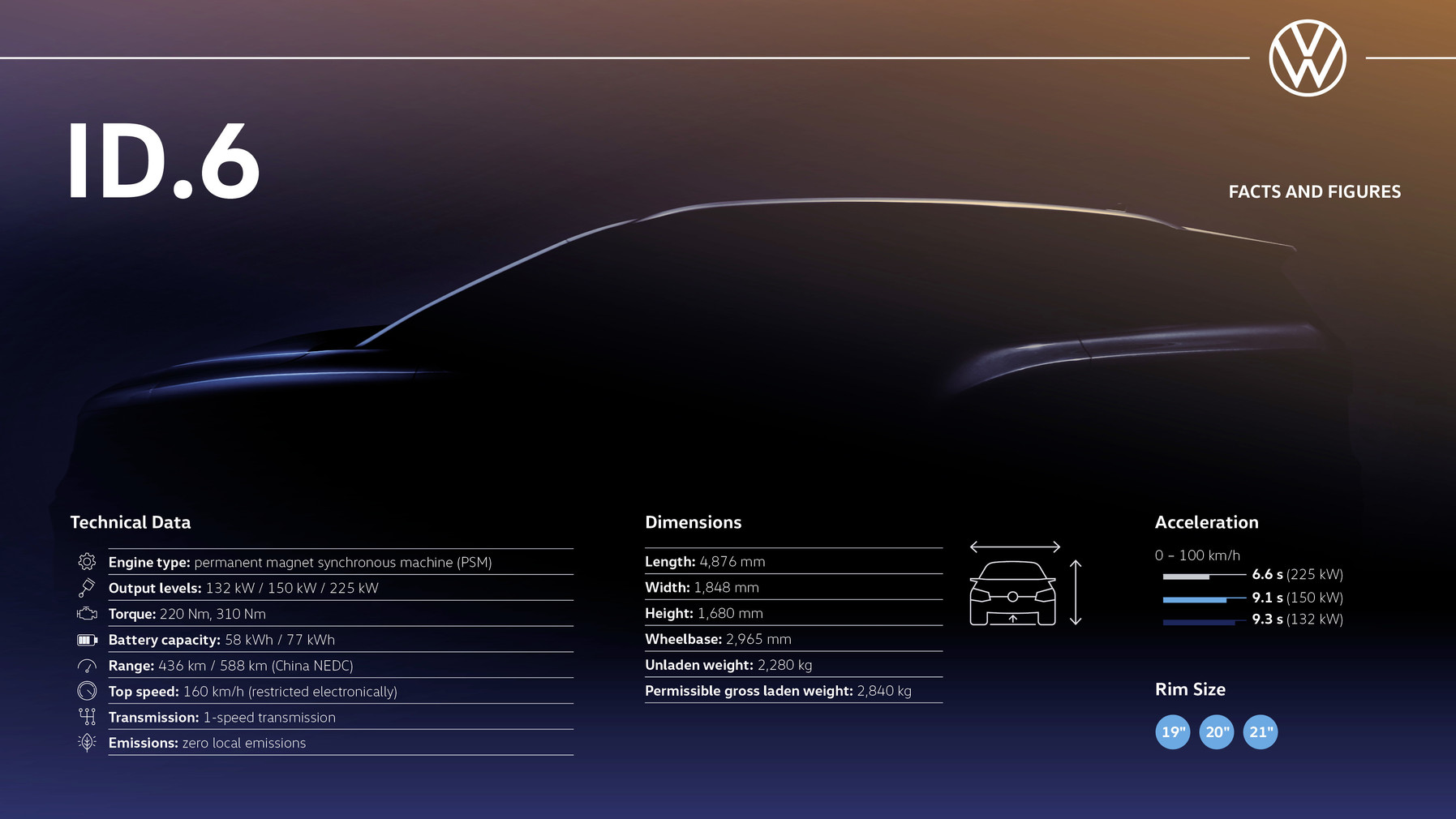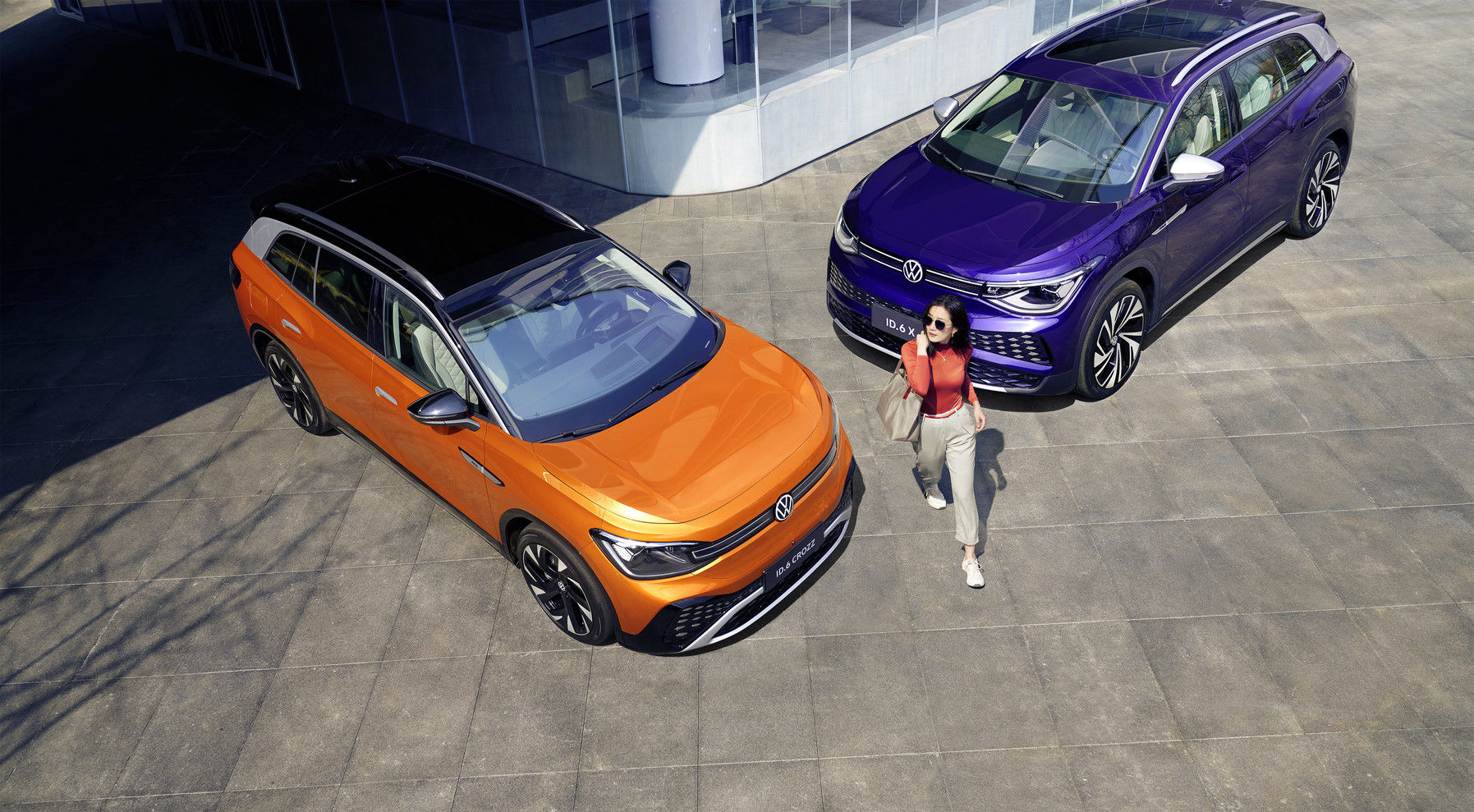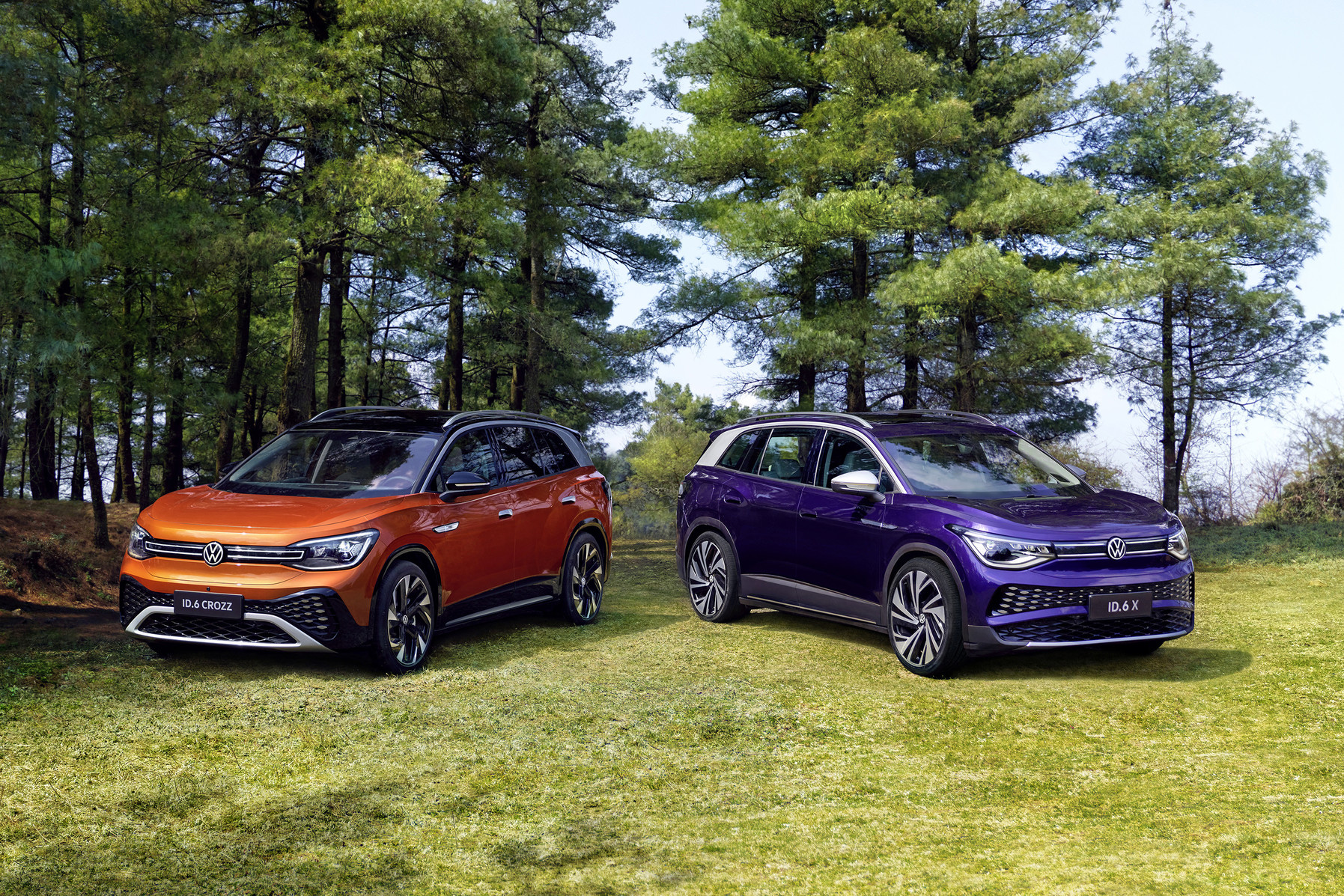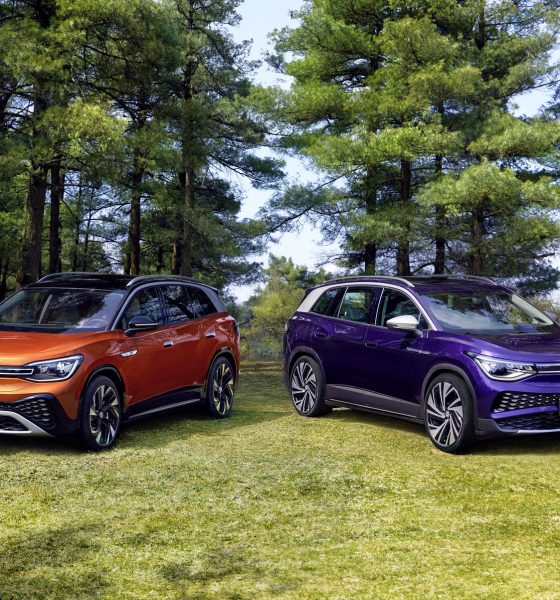Volkswagen has announced the launch of the new ID.6 all-electric SUV. The vehicle is a mainstay in the German automaker’s plan to infiltrate some of the Chinese electric vehicle market that has quickly established itself as one of the most competitive globally. Volkswagen’s ID.6 is catered specifically to the Chinese market, and the automaker has no plans to launch the vehicle in any other region, including the European market.
Volkswagen unveiled the ID.6 on April 17th at 8 AM EST. The new SUV from VW will only be available in one country: China, as its design, infrastructure, and technological developments are all catered to match the wants and needs of Chinese consumers. Volkswagen has plans for China to take its EV plan into the stratosphere in the coming years, eventually becoming the area where it will sell 50% of its EVs globally, hopefully by 2030.
“A desire for roomy interiors, safety and comfort, coupled with a high level of interest in technology and connectivity – China is a market like no other,” Volkswagen wrote in a press release that outlined the ID.6’s potential in China. The vehicle utilizes the MEB platform that will power each of the vehicles in the ID. family, including the already-released ID.3 and ID.4. However, the ID.6 offers drivers increased cargo and passenger capacity thanks to three rows of seats suitable for up to seven passengers. The design of the ID.6 “sets new standards in terms of space, functionality, design, and, in particular, user experience. The car is thus tailored specifically to the needs and wishes of Chinese customers.”
ID.6 Facts and Figures (Credit: Volkswagen)
Interestingly, Volkswagen’s press release included a paragraph regarding the potential of competitors in the region. While mentioning NIO and Xpeng, Volkswagen made no mention of Tesla or Wuling, two vehicle manufacturers that have long dominated China’s EV sales figures. Nevertheless, Volkswagen says it knows Chinese EV companies are developing highly competitive and disruptive cars, especially ones that fit the trend of New Energy Vehicles and Intelligent Connected Vehicles.
“As a result, one difference in our ID. models in China is that they will have a high level of computing power and a robust software platform in order to provide customers with the necessary digital and connectivity services,” Volkswagen wrote. The increased computing power will allow owners to check for updates on air quality or traffic violations, fitting the needs of consumers in the market, it says.
The ID.6 is just one of eight pieces of the puzzle Volkswagen needs to place in China. The company says it plans to launch a total of eight ID. vehicles by the end of 2023 in an effort to become the most popular new energy vehicle brand in the region. With a design specific for Chinese consumers, the ID.6 will be Volkswagen’s flagship SUV in the country, and car buyers will have choices.

ID.6 CROZZ by FAW and ID.6 X by SVW (Credit: Volkswagen)
The ID.6 will have two variants: SAIC Volkswagen ID.6 X and FAW-Volkswagen’s ID.6 CROZZ. Both cars will not be available in Europe, nor will they be available in Germany.
Volkswagen will look to make a statement with its rollout of all-electric cars in China. “China is one of the most important markets globally for Volkswagen, and will continue to play an essential role in the future success of our transformation to electrification and digitization. We see the ID.6 as the next building block for Volkswagen to also become the leading brand for sustainable mobility in China, as we are for ICE vehicles.”
https://www.youtube.com/watch?v=Rf0y4FZVmcs

News
Tesla FSD fleet is nearing 7 billion total miles, including 2.5 billion city miles
As can be seen on Tesla’s official FSD webpage, vehicles equipped with the system have now navigated over 6.99 billion miles.

Tesla’s Full Self-Driving (Supervised) fleet is closing in on almost 7 billion total miles driven, as per data posted by the company on its official FSD webpage.
These figures hint at the massive scale of data fueling Tesla’s rapid FSD improvements, which have been quite notable as of late.
FSD mileage milestones
As can be seen on Tesla’s official FSD webpage, vehicles equipped with the system have now navigated over 6.99 billion miles. Tesla owner and avid FSD tester Whole Mars Catalog also shared a screenshot indicating that from the nearly 7 billion miles traveled by the FSD fleet, more than 2.5 billion miles were driven inside cities.
City miles are particularly valuable for complex urban scenarios like unprotected turns, pedestrian interactions, and traffic lights. This is also the difference-maker for FSD, as only complex solutions, such as Waymo’s self-driving taxis, operate similarly on inner-city streets. And even then, incidents such as the San Francisco blackouts have proven challenging for sensor-rich vehicles like Waymos.
Tesla’s data edge
Tesla has a number of advantages in the autonomous vehicle sector, one of which is the size of its fleet and the number of vehicles training FSD on real-world roads. Tesla’s nearly 7 billion FSD miles then allow the company to roll out updates that make its vehicles behave like they are being driven by experienced drivers, even if they are operating on their own.
So notable are Tesla’s improvements to FSD that NVIDIA Director of Robotics Jim Fan, after experiencing FSD v14, noted that the system is the first AI that passes what he described as a “Physical Turing Test.”
“Despite knowing exactly how robot learning works, I still find it magical watching the steering wheel turn by itself. First it feels surreal, next it becomes routine. Then, like the smartphone, taking it away actively hurts. This is how humanity gets rewired and glued to god-like technologies,” Fan wrote in a post on X.
News
Tesla starts showing how FSD will change lives in Europe
Local officials tested the system on narrow country roads and were impressed by FSD’s smooth, human-like driving, with some calling the service a game-changer for everyday life in areas that are far from urban centers.

Tesla has launched Europe’s first public shuttle service using Full Self-Driving (Supervised) in the rural Eifelkreis Bitburg-Prüm region of Germany, demonstrating how the technology can restore independence and mobility for people who struggle with limited transport options.
Local officials tested the system on narrow country roads and were impressed by FSD’s smooth, human-like driving, with some calling the service a game-changer for everyday life in areas that are far from urban centers.
Officials see real impact on rural residents
Arzfeld Mayor Johannes Kuhl and District Administrator Andreas Kruppert personally tested the Tesla shuttle service. This allowed them to see just how well FSD navigated winding lanes and rural roads confidently. Kruppert said, “Autonomous driving sounds like science fiction to many, but we simply see here that it works totally well in rural regions too.” Kuhl, for his part, also noted that FSD “feels like a very experienced driver.”
The pilot complements the area’s “Citizen Bus” program, which provides on-demand rides for elderly residents who can no longer drive themselves. Tesla Europe shared a video of a demonstration of the service, highlighting how FSD gives people their freedom back, even in places where public transport is not as prevalent.
What the Ministry for Economic Affairs and Transport says
Rhineland-Palatinate’s Minister Daniela Schmitt supported the project, praising the collaboration that made this “first of its kind in Europe” possible. As per the ministry, the rural rollout for the service shows FSD’s potential beyond major cities, and it delivers tangible benefits like grocery runs, doctor visits, and social connections for isolated residents.
“Reliable and flexible mobility is especially vital in rural areas. With the launch of a shuttle service using self-driving vehicles (FSD supervised) by Tesla in the Eifelkreis Bitburg-Prüm, an innovative pilot project is now getting underway that complements local community bus services. It is the first project of its kind in Europe.
“The result is a real gain for rural mobility: greater accessibility, more flexibility and tangible benefits for everyday life. A strong signal for innovation, cooperation and future-oriented mobility beyond urban centers,” the ministry wrote in a LinkedIn post.
News
Tesla China quietly posts Robotaxi-related job listing
Tesla China is currently seeking a Low Voltage Electrical Engineer to work on circuit board design for the company’s autonomous vehicles.

Tesla has posted a new job listing in Shanghai explicitly tied to its Robotaxi program, fueling speculation that the company is preparing to launch its dedicated autonomous ride-hailing service in China.
As noted in the listing, Tesla China is currently seeking a Low Voltage Electrical Engineer to work on circuit board design for the company’s autonomous vehicles.
Robotaxi-specific role
The listing, which was shared on social media platform X by industry watcher @tslaming, suggested that Tesla China is looking to fill the role urgently. The job listing itself specifically mentions that the person hired for the role will be working on the Low Voltage Hardware team, which would design the circuit boards that would serve as the nervous system of the Robotaxi.
Key tasks for the role, as indicated in the job listing, include collaboration with PCB layout, firmware, mechanical, program management, and validation teams, among other responsibilities. The role is based in Shanghai.
China Robotaxi launch
China represents a massive potential market for robotaxis, with its dense urban centers and supportive policies in select cities. Tesla has limited permission to roll out FSD in the country, though despite this, its vehicles have been hailed as among the best in the market when it comes to autonomous features. So far, at least, it appears that China supports Tesla’s FSD and Robotaxi rollout.
This was hinted at in November, when Tesla brought the Cybercab to the 8th China International Import Expo (CIIE) in Shanghai, marking the first time that the autonomous two-seater was brought to the Asia-Pacific region. The vehicle, despite not having a release date in China, received a significant amount of interest among the event’s attendees.










